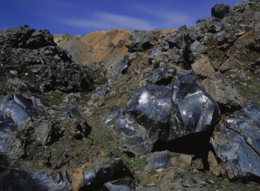v50 Steam/Premium information for editors
- v50 information can now be added to pages in the main namespace. v0.47 information can still be found in the DF2014 namespace. See here for more details on the new versioning policy.
- Use this page to report any issues related to the migration.
This notice may be cached—the current version can be found here.
DF2014:Igneous extrusive layer
(Redirected from DF2014:Igneous extrusive)
Jump to navigation
Jump to search
| This article is about an older version of DF. |
Igneous extrusive stone layers are formed from andesite, basalt, dacite, obsidian, and rhyolite. Of these five, andesite, dacite, and rhyolite are functionally identical, different only in appearance and name, basalt is like the other three except that it is magma-safe, and obsidian is... unique.
Igneous extrusive layers[edit]
Stone found in igneous extrusive layers[edit]
- Hematite (veins)
- Native copper (veins)
- Galena (veins)
- Cinnabar (veins)
- Brimstone (small clusters)
- Realgar (small clusters)
- Orpiment (small clusters)
- Stibnite (small clusters)
- Native aluminum (small clusters)
- Alunite (large clusters)
Stone appearing in both igneous intrusive and igneous extrusive layers[edit]
- Native gold (veins)
- Cobaltite (veins)
- Pyrolusite (small clusters)
- Hornblende (small clusters)
Gems found in igneous extrusive layers[edit]
- Turquoise (small clusters)
Gems appearing in both igneous intrusive and igneous extrusive layers[edit]
- Black zircon (small clusters)
- Green zircon (small clusters)
- Red zircon (small clusters)
- Brown zircon (small clusters)
- Yellow zircon (small clusters)
- Clear zircon (small clusters)
* See also: stone found everywhere
In Real Life[edit]
In real-world geology, Igneous extrusive stone is formed by lava solidifying above the surface, open to the air. This is the main point of difference from igneous intrusive stone, which solidifies below the surface. This distinction is not kept in Dwarf Fortress geology, in which the difference is simply the name and contents of the two types of stone.
| Sedimentary | |||||
|---|---|---|---|---|---|
| Igneous |
| ||||
| Metamorphic | |||||
| Ore | |||||
| Economic | |||||
| Other |
Alunite · Anhydrite · Bauxite · Borax · Brimstone · Chromite · Cinnabar · Cobaltite · Cryolite · Graphite · Hornblende · Ilmenite · Jet · Kimberlite · Marcasite · Mica · Microcline · Olivine · Orpiment · Orthoclase · Periclase · Petrified wood · Pitchblende · Puddingstone · Pyrolusite · Realgar · Rutile · Saltpeter · Serpentine · Slade · Stibnite · Sylvite · Talc | ||||
